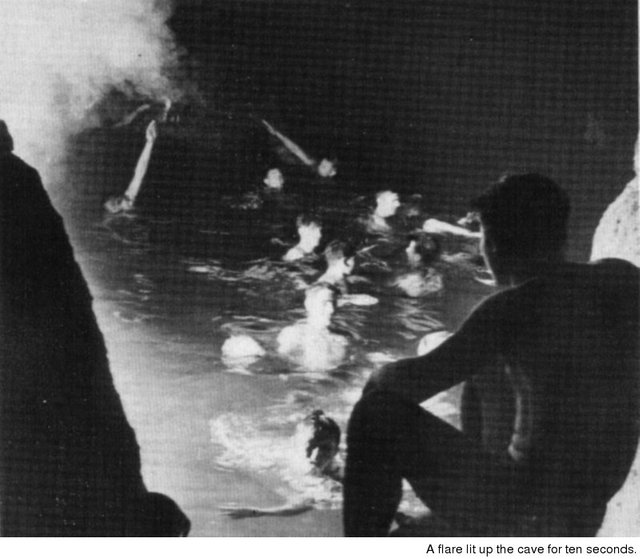A Cave in the Kopet Dag Mountains (featuring Vasily Peskov as author)
I was accompanying a mounted border patrol in the foothills of the Kopet Dag Mountains. To the left the cliffs rose high and sheer, to the right lay the vacant, sun-scorched, windswept steppe.
"Feel like swimming?"
"These soldiers are a lively bunch. They know the only way to keep up your spirits in a place like this is with a joke," I said to myself. A few moments later [ looked on in amazement as they dismounted and began pulling off their shirts.
There was a dark hole in the cliff. We descended into the stone cave one by one. Ten meters down a shaky ladder ended in a rocky slope. Here was the cave. Our voices echoed. It was so close my shirt stuck to my back.
"It's the vapors from the sulphur lake," one of the men said.
With each successive step the cave became darker and hotter. Our torch went out. While we were hunting for matches I managed to reload my camera, for the darkness was ideal.

The underground lake was another hundred paces away. It was about thirty meters across and apparently quite deep, but the water was amazingly clear. We could see the time-polished stones on the bottom.
I dived in. The water was very warm, nearly hot, but pleasant, although extremely bitter to the taste. We did not venture far, just splashed around near a jutting rock. One of the bolder fellows headed past the dark bend but swam right back again, for being all alone in the unusually warm water and in total darkness would make anyone uneasy.
As we sat resting on the rocks I listened to their stories about the cave, which they often visited. The water here obviously has healing qualities, since after just one dip minor sores and scratches disappear. There is a current in the lake, for the small raft someone knocked together always headed for the same cove. However, not even the geographers in Ashkhabad who explored the cave know where the water comes from or where it goes.
We spent about two hours in this mountain bath. I felt it was high time we returned, but the men were so tired of the hot sun that they were in no hurry to leave. After a while I set my camera. One of the men secured a flare just beyond the little cape. I waited for his signal.
A light as blue as that of a welder's torch filled the cave. It hurt our eyes. In a matter of seconds we managed to examine the high, sooty ceiling and the jumble of huge blocks of limestone. I learned that in 1929 a group of sightseers was caught in an earthquake here. The thunder in the cave was like an artillery barrage. Bits of rock showered down on them, but the underground chamber withstood the tremors, as it did again during the severe earthquake of 1948.
We had not seen the sun for two and a half hours. It was burning as unbearably as ever when we emerged and so we decided to wait at the cave's entrance until the cool of the evening set in.
"You're lucky," the sergeant said. "You're going to see something you've never seen before."
Three hours later the sun rolled over the tops of the mountains like a fiery disc and I witnessed "something I had never seen before".
A bat squeaked and disappeared into the darkness outside. It was followed by another and then a third bat. Soon the winged inhabitants of the cave were flying out into the steppe in droves. The mountain seemed to me like a giant beehive filled with swarming bees. The bats were now winging out in an uninterrupted stream. The swishing sound was like the rustle of a summer downpour. Half an hour passed. The avalanche kept increasing. The bats soared over our heads, to be swallowed up by the steppe. They were out for the night's hunting. The exodus continued for over an hour.